Sterling/Euro Exchange Rate Review June 2017
Tuesday 11 July 2017
The pound to euro exchange rate experienced swings between €1.1552 and €1.1270 in June due to the UK general election result and ongoing political chaos, writes Ben Scott.
The Pound Loses in the Election
Unfortunately for sterling, the general election did not yield the results many experts had predicted. Theresa May called the election in order to strengthen her Brexit hand, but instead weakened it significantly with a no parliamentary majority, a deal with the controversial Democratic Unionist Party (DUP), and rumours of a revolt around the corner.
Sterling sank from 1.1552 (point A) to 1.1376 as the exit poll results were announced, before dropping even further to 1.1282 as markets digested the results in the few days that followed. Despite having a few strengthening sessions, the pound approached the end of June at its lowest levels of the month, in the region of 1.1270 (point B).

US Dollar Weakens – GBP and EUR Rally
Markets were surprised when European Central Bank (ECB) President Mario Draghi encouraged a euro rally with his positivity that verged on hawkish. The euro to US dollar (EUR/USD) exchange rate reached a fresh 2017 high as Draghi commented on the Eurozone’s recovery and suggested that ‘deflationary forces have been replaced by reflationary ones.’
Although the ECB chief retained his monetary policy rhetoric of stimulus remaining loose, investors took it as a sign that the Eurozone could soon see some tightening. JPMorgan strategist Mike Bell commented: ‘Mr Draghi’s point in the speech was that the ECB needs to tighten just to stand still, as the dynamics of the eurozone economy improve without being disrupted by inflation.’
Markets are now largely expecting a tapering of stimulus in the near future and it’s likely the official announcement will signal further euro strengthening.
Trump Disappoints Dollar Bulls
Meanwhile, the pound has also managed to reach post-election highs versus the US dollar following central bank comments and the revision of the International Monetary Fund’s (IMF’s) US growth expectations. The IMF suggested that Gross Domestic Product (GDP) will reach only 2.1% in 2017, down from the 2.3% previously forecast.
The IMF’s previous predictions had been based around expectations that newly inaugurated President Donald Trump would be able to enhance growth on the back of his promises to boost fiscal spending and reduce taxes. Had these pledges come to light, economic growth would have likely seen an improvement. However, Trump seems to have spent several months in the White House with little progress on delivering what he’d promised. Moreover, the IMF also criticised the President’s budget proposals, suggesting that they would provide a significant advantage to the US’s wealthiest citizens.
It’s not looking good for Trump who’s failing to repeal Obamacare with members of his own Republican Party refusing to vote on the bill as it stands. The lack of progress by Trump has caused markets to lose confidence in the potential for additional spending and tax reform, creating a weak spot in the US dollar. GBP/USD reached highs of around 1.2969, while EUR/USD hit levels of 1.1384.
Economic Data to Impact GBP/EUR
At the start of June the UK released its trade balance figure for April which showed the nation’s deficit had narrowed to £2.1 billion from the previous month’s reading of £3.9 billion, despite forecasts for £3.5 billion. The Office for National Statistics (ONS) noted a sharp drop in imports, especially in areas of oil, cars, and machinery. However, economists are growing concerned that the election result could catalyse weak economic growth, despite the UK remaining relatively resilient post-Brexit.
Furthermore, the UK’s industrial output failed to reach forecasts in April according to the ONS and the sector only registered a meagre 0.2% growth, instead of the 0.7% prediction.
The ONS report read: ‘Total production output for April 2017 compared with April 2016 decreased by 0.8%, with energy supply providing the largest downward contribution, decreasing by 7.4%.’
Meanwhile, UK inflation levels surged, coming in at 2.9% on the year in May, rather than the 2.7% forecast. Despite a spike in consumer prices, the three months through June showed the strongest rise in supermarket sales since 2012. In comparison, the same time period in 2016 registered a decline of 0.2%. Perhaps the most difficult issue facing the UK economy and British consumers is sluggish wage growth amid a backdrop of rampant inflation. Bank of England (BoE) Governor Mark Carney has suggested the squeeze on households this year will be difficult.
Bank of England Creates GBP/EUR Movement
At the start of the month Carney stated that now is not the time for monetary policy adjustments, yet by the end of the month had changed his tune and caused the pound to rally (point C).
Carney said in Sintra at the European Central Bank Forum: ‘Some removal of monetary stimulus is likely to become necessary if the trade-off facing the MPC [Monetary Policy Committee] continues to lessen and the policy decision accordingly becomes more conventional. When the MPC last met earlier this month, my view was that given the mixed signals on consumer spending and business investment, it was too early to judge with confidence how large and persistent the slowdown in growth would prove. Moreover, with domestic inflationary pressures, particularly wages and unit labour costs, still subdued, it was appropriate to leave the policy stance unchanged at that time.’
Earlier in the month three members of the MPC had called for higher interest rates, followed by BoE Chief Economist Andy Haldane stating he may also suggest a rate rise in the near future.
Meanwhile in the Eurozone, GDP growth came in better than expected at 1.9% on the year in Q1, and Eurozone consumer confidence also made an improvement from -3.3 to -1.3. Germany’s business climate survey jumped from 114.6 to 115.1 in June, the highest level since 1991.
GBP/EUR Outlook
With both the ECB and BoE hinting at tighter monetary policy, the GBP/EUR exchange rate could be in for an interesting third quarter. In terms of economic data, UK and Eurozone unemployment rate and earnings numbers are likely to be factors that influence the exchange rate, as well as inflation numbers. Post-Brexit referendum, markets are also keeping a close watch on UK GDP growth rates looking for signs of a slowdown.
In June Italy was forced to bail out two large banks which cost the government a total of €5.2 billion. The Italian banking system is riddled with bad loans, totaling in the region of €350 billion. Italy’s contribution makes up a third of the currency bloc’s bad debt. Developments in Greece may also contribute towards euro movement in coming months.
Long-term, the German election is fast approaching and there’s a possibility that there may be a snap election in Italy around the time that Germany votes. For the UK, shaky politics and Brexit negotiations are likely to create GBP/EUR movement.
Ben Scott
Foreign Exchange Ltd
www.fcexchange.co.uk
Thank you for showing an interest in our News section.
Our News section is no longer being published although our catalogue of articles remains in place.
If you found our News useful, please have a look at France Insider, our subscription based News service with in-depth analysis, or our authoritative Guides to France.
If you require advice and assistance with the purchase of French property and moving to France, then take a look at the France Insider Property Clinic.





